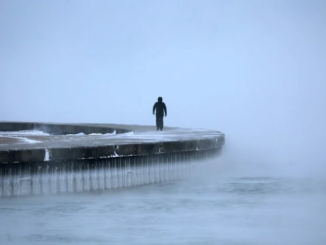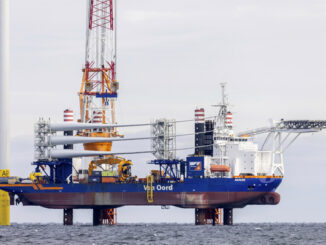
It’s not something Rep. Lloyd Smucker can recall seeing: all of York County and Lancaster County’s representatives, united.
The cause? Opposing the Cuffs Run hydroelectric project, which was provisionally accepted by the Federal Energy Regulatory Commission earlier this month.
Overlooking the Susquehanna River at John Wright Restaurant in Wrightsville on Monday, Smucker, R-Lancaster, and other elected officials made their opposition clear.
“There’s so much more that brings these counties together than divides us, and I think the river itself unites both counties,” Smucker said. “We, as elected officials representing both counties, stand here today united to announce our opposition to the preliminary permit application submitted to FERC for proposed construction of a hydroelectric pump storage facility at Cuffs Run, proposed by York Energy Storage LLC.”
The proposal from York Energy Storage seeks to build a dam roughly 1.9 miles long and 225 feet high along the river, creating a 600-acre upper reservoir through flooding and using nearby Lake Clarke as a lower reservoir. The plan includes securing land rights of nearly 50 properties — possibly through eminent domain.
Last year, FERC rejected the project — whose costs have increased since then, from an original estimate of $2.1 billion to $2.3 billion. That rejection had noted that previous maps submitted by the developer did not clearly delineate project boundary lines, but it left the door open for subsequent submissions.

‘We have our fair share’: President Commissioner Julie Wheeler, in her remarks Monday, said York County contributes more than its fair share of energy. She highlighted the York Haven Hydro, Safe Harbor and Holtwood dams along the Susquehanna, which she said cumulatively produce 136,000 megawatts of power.
“Although dams provide an opportunity to store water, produce energy and prevent flooding, they do unquestionably impact the environment,” Wheeler said. “While these issues are not unique to York County, it’s fair to say we have our fair share of dams, produce our fair share of energy and deal with our fair share of environmental impacts as a result.”

Wheeler also highlighted the economic impact of the river, saying an economic impact report by the York County Economic Alliance showed 5,240 York County residents work in the outdoor economy, generating $135 million in revenue.
State Sen. Kristin Phillips-Hill, R-York Township, called the project “horrendous” and blamed people outside York County, including the developers and Maryland.
“It is the failed policies of the state of Maryland that is driving this atrocity, and we have had enough,” Phillips-Hill said during the news conference. “In its rush to be green and carbon free by some arbitrary deadline, Maryland will be shutting down a power plant that generates reliable electricity for the people of Baltimore.”

Phillips-Hill was referring to the forthcoming closure of the coal-powered Brandon Shores Power Plant in Pasadena, Maryland, which Talon Energy agreed to close in 2025 as part of an agreement with the Sierra Club, as reported by the Baltimore Sun.
“The target is on York County farmers and groups dedicated to preserving and protecting our incredible natural resources,” Phillips-Hill said.
Before the news conference, Lancaster Conservancy president and CEO Fritz Schroeder gave a presentation to attendees. He also spoke at the news conference, noting that the conference was happening in the federally designated Susquehanna National Heritage Area and that the region needs to look past immediate and short-term gains for a few people.

“It is a region that has historic, cultural and national significance,” Schroeder said. “Along with our partners at the Susquehanna National Heritage Area, the Lower Susquehanna Riverkeeper and the Farm and Natural Land Trust of York County, along with the Cuffs Run Alliance, we will continue to oppose this project.”
Other speakers included Lancaster County Chairman Commissioner Josh Parsons and state Rep. Wendy Fink, R-Windsor Township.
While he did not speak at the news conference, Commissioner Doug Hoke also said he opposes the project, noting he serves on the board of directors for the Lancaster Conservancy. Vice President Commissioner Scott Burford also opposes the project, though he did not attend.
Other York County legislators attending the news conference included Reps. Joseph D’Orsie, R-Mount Wolf, Dawn Keefer, R-Franklin Township, Kate Klunk, R-Hanover, and Seth Grove, R-Dover Township.
In an email, one of the developers, William McMahon, said he believes the politicians are misinformed and that he would have liked to have been at the event.
“It is a shame that some of these politicians did not try to find out more about the York Energy Storage project before taking a position,” McMahon said. “If they did, I think they would change their minds – nothing but benefits for the future for their constituents and the wider grid.”
Next steps: Celeste Miller, FERC spokesperson, said earlier this month that the acceptance of the application means the application is complete and that FERC is now seeking public comment.
“Once we get all of the comments at the end of the 60-day period, we’ll review them, review the application and make a decision on whether or not to issue a preliminary permit,” Miller said.
Miller said a preliminary permit gives a period of time, usually four years, to study a site and determine if the developer wants to pursue a license for the project, which is a separate application. It doesn’t authorize any type of construction, but it gives priority to the developer to study the site and file a license application.
In a letter submitted to FERC, the York and Lancaster delegations say the project would disrupt the Susquehanna National Heritage Area as well as the Captain John Smith Chesapeake National Historic Trail.
“This project, if allowed to proceed, would destroy preserved farms, a regional scenic trail, the viewshed of a popular multimodal rail trail and forested lands needed to help protect the ecological health of this landscape and an already impaired waterway,” the letter reads. “The impacted area is one of the last bits of unprotected nature on the river, and we believe it is worth fighting for. Additionally, nearly forty families could be displaced as a result of this project.”
ENB Top News
ENB
Energy Dashboard
ENB Podcast
ENB Substack



